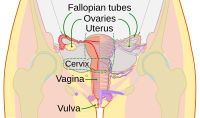
Photo from wikipedia
ABSTRACT The purpose of this study was to determine the most appropriate seed arrangement by comparing two different methods (linked seeds and loose seeds). A total of sixty-one patients (28… Click to show full abstract
ABSTRACT The purpose of this study was to determine the most appropriate seed arrangement by comparing two different methods (linked seeds and loose seeds). A total of sixty-one patients (28 linked seed brachytherapy cases and 33 loose seed brachytherapy cases) with clinically localized prostate cancer were treated with I-125 permanent prostate brachytherapy. Modified peripheral loading was the method used for seed placement. The parameters evaluated were as follows: prostate D90, V100, and V150; urethral D90, D10, and D5; and rectal V100 (RV100) and D2 (RD2). Coefficient parameters (r and r2) were assessed by regression analysis. Prostate V150, urethral D90, urethral D10, urethral D5, and RD2 showed significant correlations between both methods in all patients. Urethral D90, urethral D10, urethral D5, and RD2 showed significant correlations in patients who received linked seed brachytherapy. Prostate V150, urethral D90, urethral D10, urethral D5, RV100, and RD2 showed significant correlations in patients who received loose seed brachytherapy. Urethral D90, urethral D10, urethral D5, and RD2 showed significant correlations in the linked seed and loose seed brachytherapy analyses. In contrast, prostate D90 and prostate V100 showed no correlation. Parameters of normal organ damage showed good correlations between intraplan and postplan parameters. These parameters may be useful to determine normal organ damage during guided brachytherapy with two different methods (linked seeds and loose seeds).
Journal Title: Nagoya Journal of Medical Science
Year Published: 2022
Link to full text (if available)
Share on Social Media: Sign Up to like & get
recommendations!